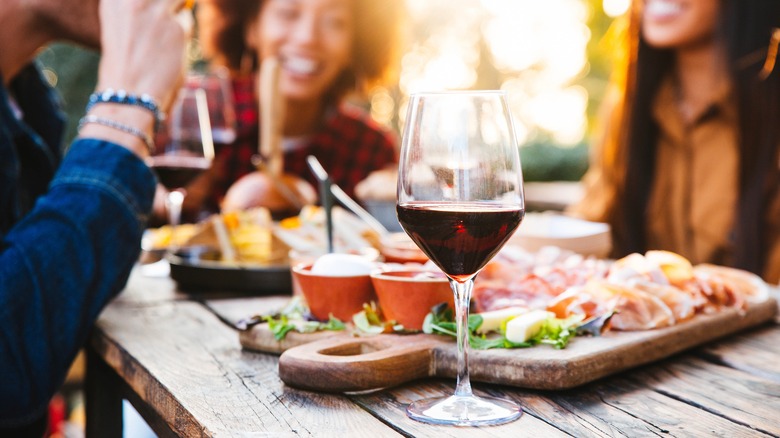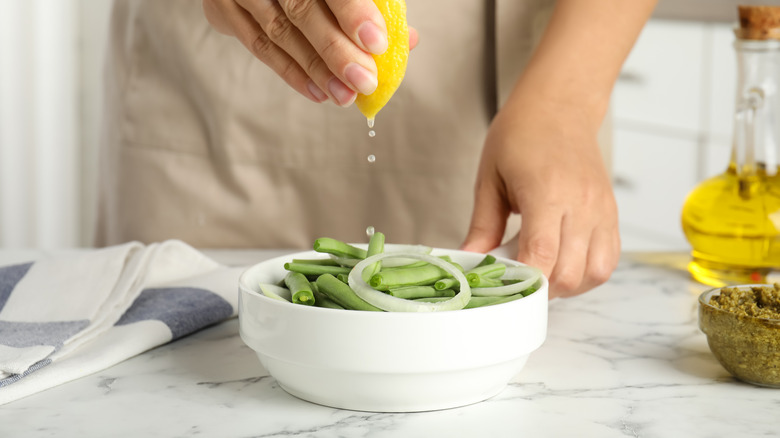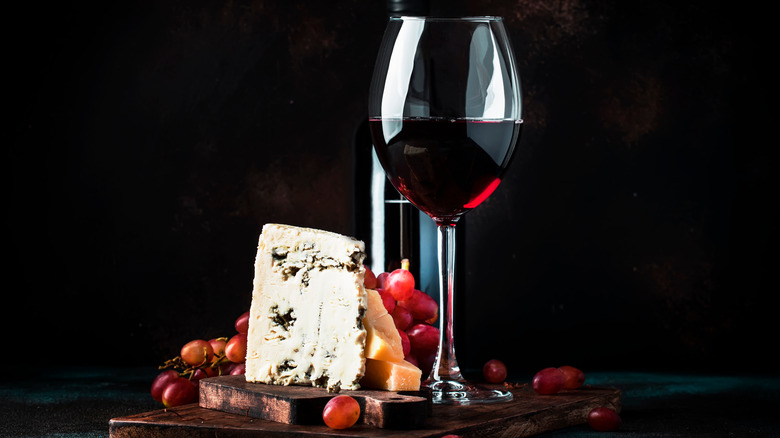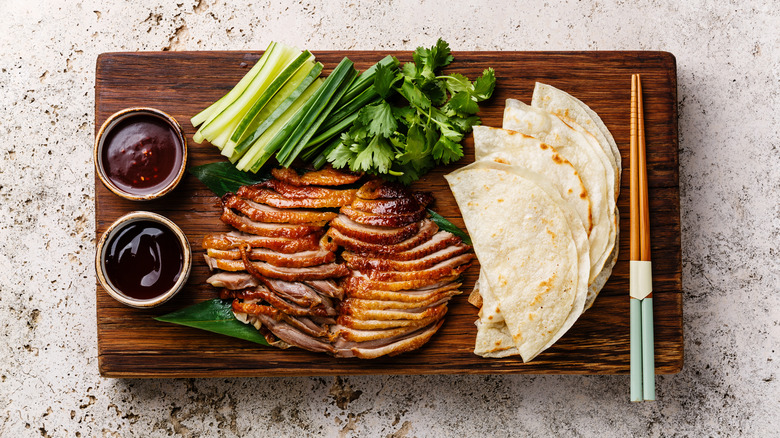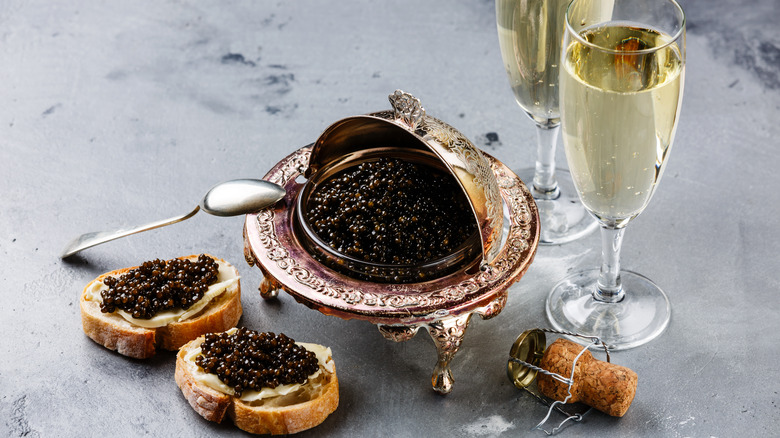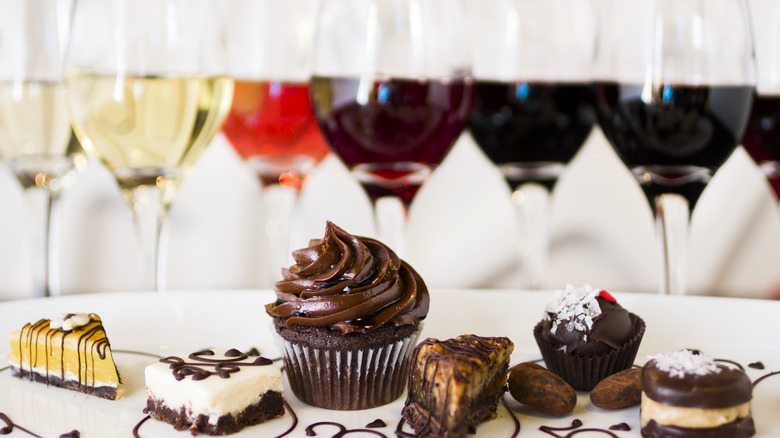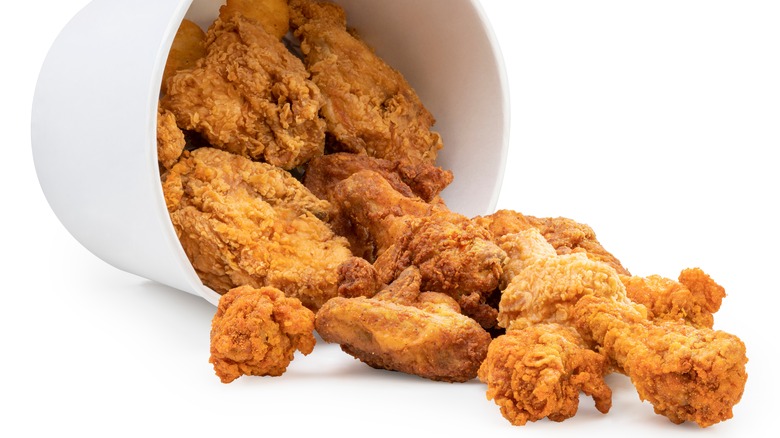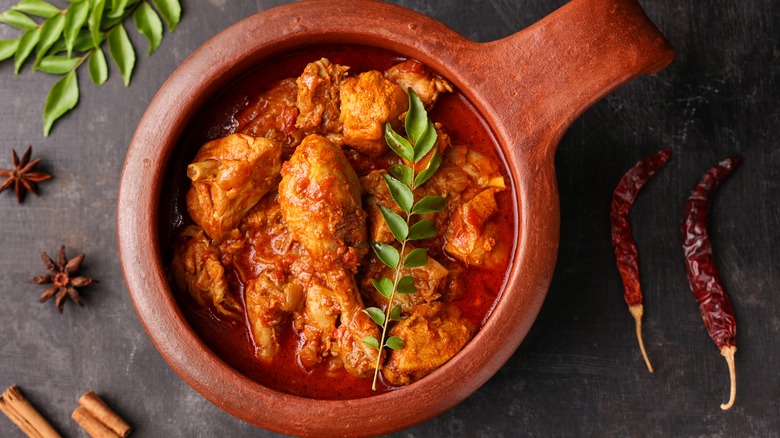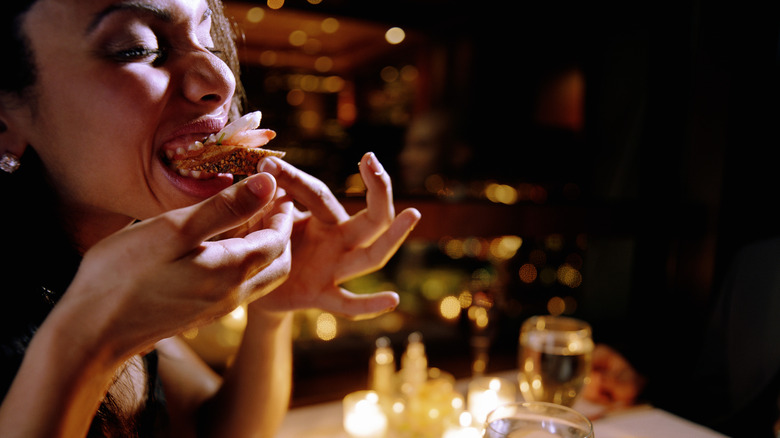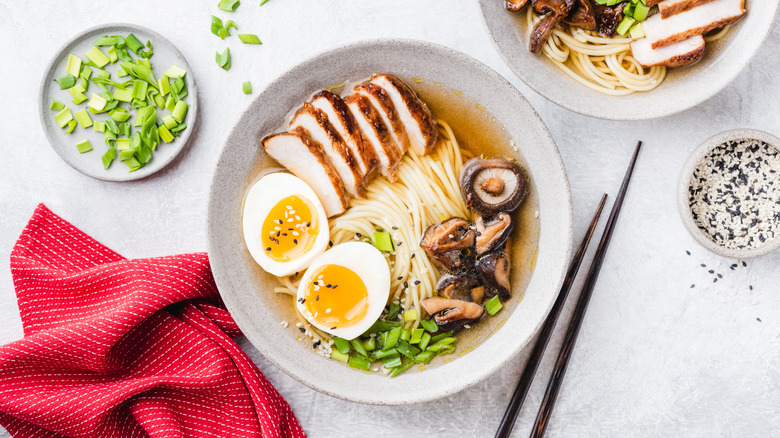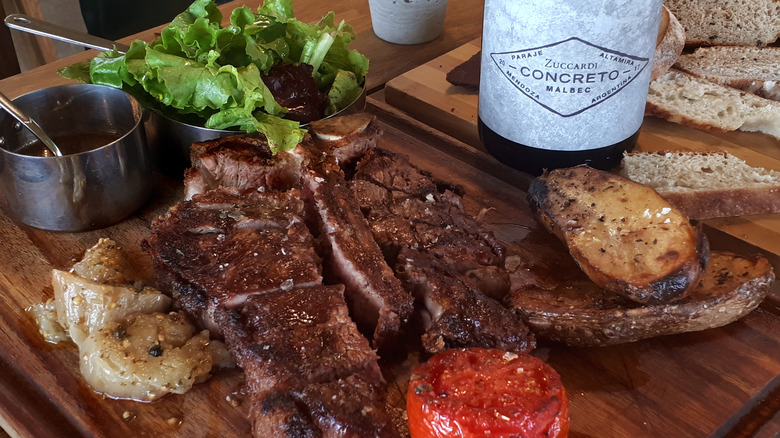13 Essential Wine Pairing Tips You Should Know
There are few foodstuffs that have had a longer or more pronounced impact on human culture than wine. As National Geographic reports, winemaking dates to at least 6,000 B.C. That's about 7,400 years earlier than the discovery of another of our society's most beloved beverages, coffee (via Britannica). Since 6000 B.C., wine has played an incredibly important part in the development of human culture with Virgin Wines reporting that the fermented drink was even worshiped by multiple ancient cultures.
Despite being part of a global society that has spent the better part of 8,000 years in the presence of wine, many of us do not fully understand the liquid with the average consumer probably being able to tell you what type of wine they like and little more. This should come as little surprise. After all, wine is a complex drink made even more so by a large, nuanced, and frequently stuffy, wine industry. This is perhaps why most people find pairing food with wine such a daunting task, despite wine having been served alongside food for millennia, as per Science of Cooking. Fortunately, there are a number of simple tips that, when followed, can simplify this intimidating aspect of dining and ensure that your wine and your food get along famously.
Drink wines that you like
As reported in The New Yorker, wine can be a particularly divisive food product, most namely due to the extremities in taste, mouthfeel, and aroma that one can encounter. When combined with the esteem some wines are nearly universally held in — for example, Burgundies — many can feel pressured to force down something they do not enjoy, simply for the fact that they feel like they should. The simple fact is that it doesn't matter how refined or well-matched your wine pairings are; if you don't like what's in the bottle in the first place, you won't enjoy the experience. So, when pairing wines, the first thing to take into account is whether you actually like the wines you are choosing. This seems like an obvious point to make but, in pursuit of the perfect pairing, many will overlook it.
Coming to the conclusion that you may not like traditionally lauded wines or their natural food partners is one that every aspiring food and wine pairer needs to come to terms with, as highlighted by The New York Times. Sticking to the recommendation of experts, above your own preferences, can be a recipe for disaster. Fortunately, the world of wine is vast — meaning there is at least one bottle to suit any preferences. As such, try simply serving a bottle of wine you enjoy alongside food that you also like. If you do this, chances are your meal will go down a treat.
Acidic foods require acidic wines
As reported by Minor's, acidic ingredients play a vital role when it comes to food, elevating the flavors around them and balancing a dish. The same can be said for acidity in wine, with it greatly affecting the flavor and mouthfeel of the liquid. As Alison Thomson, an established winemaker notes (via Wine Enthusiast), "A higher acid wine is more lemony, and it makes your mouth water and pucker up a bit. It makes you want to drink more." She also added that a wine's pH level can be viewed as a "reflection of the stability of the wine."
When it comes to pairing wine with acidic dishes such as fresh tomatoes or lemon-rich pasta, an acidic wine should nearly always be used. This is because acidic foods will dull pretty much every wine they come into contact with (per The Washington Post). If you use an acidic wine such as Riesling, this dulling will serve to accentuate the wine's other flavors, making it seem fruitier. However, if a low-acidic wine like Chardonnay or Malbec is used, the wine will become heavy, listless, and almost tasteless.
Match the intensity of your dish
Pairing wine and food can be an intricate business. A way to simplify things is to try to remember that the overarching goal is to create synergy between the two, with both complementing and accentuating the other. What you desperately want to avoid is having one become overly dominant, as this leads to a one-dimensional dining experience. Consequently, matching the intensity of wine and food is an integral step when it comes to pairing. This approach is explained by Chris Simons, the Beverage Director at a Michelin-starred restaurant: "[L]ook for a wine that has a similar intensity to the dessert," he advises (via The Michelin Guide). "If you pair something beautifully rich such as chocolate ganache with something lighter like a semi-sweet riesling, the wine will get lost. The same goes the other way. A lighter fruit- or citrus-based dessert will be completely overpowered by something like a PX sherry."
The same ideas apply when it comes to savory dishes. Intense, flavorful ingredients like Stilton cheese demand equally powerful wines, as per Good Pair Days. On the other hand, delicate wines such as Burgundy should be paired with equally light flavors present within dishes such as Vietnam's Bánh xèo (per Tatler Asia).
Focus on the dish's dominant flavor
While our eyes may be drawn to the biggest or most expensive item on the plate, this ingredient often doesn't provide the dominant flavor of the dish. One such example would be Peking duck. This Cantonese classic seems on first appearance to be all about the bird, but the dominant flavor is usually the sweet plum sauce that accompanies it, as per Fine Dining Lovers. When pairing wine with food it is important to look past the "star" of your dish — in this instance, the duck — and instead identify the dish's dominant flavor.
Pairing your wine with the dominant flavor ensures that the wine and the dish will complement each other in their entirety. Conversely, pairing the wine with the "star" means that it will only suit that singular aspect of the meal, leaving the rest up to chance. As reported by Decanter, this tip can be a little tricky to implement and requires some forethought. However, gaining a thorough understanding of the dish you plan to serve — and in particular, its flavors — will go a great way in facilitating matters.
Mirror or contrast flavors
There are two main ways to approach pairing wine with food. The safest option is to mirror the food's flavors. This is achieved by selecting a wine that presents similar flavors and characteristics to the food itself. For example, a crisp, light white wine served with a salad drizzled with lemon vinaigrette, as per VinePair. The idea behind mirroring is that similar flavors and textures accentuate each other's presence.
Alternatively, you can choose to contrast flavors. This approach presents more risks as startling — and often unwelcome — clashes can occur. However, if executed properly, the end result can be complex, rewarding, and surprising (via The Mercury News). The most typical example of contrasting pairings is the use of an acidic, tart wine to cut through a rich, fatty meal, such as serving dry Champagne with extremely rich caviar. Again, this notion is explained by sommelier Chris Simons (via The Michelin Guide), albeit in terms of dessert: "I like to try and bring a little contrast between the two while retaining the complementary flavours. This can add a little more depth and complexity to the whole dessert experience. For example, a sweet dry wine such as a Sauternes or Tokaji paired with crème brûlée allows the citrus and tropical notes of the wine to really play off the density of the caramel."
Dessert can be a wine's downfall
While all courses pose challenges of their own, pairing wine with desserts is a practice especially fraught with difficulty. This is not only because desserts can pack a punch, but also because people often think sweet wines are the only option. A notion that is incorrect, as sommelier Arvid Rosengren highlights (via Decanter): "The most common challenge is when diners want to drink sweet wines like Sauternes with dessert, especially with cold elements like ice cream. It's rarely a good idea and I try to persuade them to go the route of fresher wines with less dry extract like Beerenauslese."
Chocolate, another popular dessert ingredient, poses its own unique challenges, most notably because the nature of chocolate can vary so much from bar to bar. As Decanter notes, knowing the style of chocolate you are going to be using is of imperative importance. Ripe white wines suit milk chocolate, while merlots are best suited for darker, punchier bars. Eataly also advises people to keep an eye out for ingredients that have been added to the chocolate. After all, the last thing you want is for your well-planned pairing to be derailed by some ginger that has not been accounted for.
Fatty, rich foods also benefit from acidic wine
As we have mentioned, sometimes pairing wine that contrasts with your food can pay dividends. This is no truer than when matching acidic wines with fatty foods. According to VinePair, all wines carry some degree of acidity. However, the extent to which wine is acidic depends on several factors. These include where and when the grapes were grown, how the wine was processed, and the steps winemakers took to either emphasize or stifle the wine's acidity, as per Wine Enthusiast.
Good Pair Days reports that a wine's acidity is one of the key factors that influences its ability to pair with foods, especially when it comes to those rich in fat. Here acidic wines come into their own, a fact that is no better exemplified than through pairing with fried chicken. As per Wine Folly, an acidic, sparkling wine such as Champagne or cava compliments the fatty chicken extremely well thanks to its ability to wipe your palate clean. This is a rarity as most beverages served with foods as greasy as fried chicken will be unable to compete with the fat that coats your mouth.
Spicy dishes require careful consideration
Just as desserts present their own special set of issues when pairing wine, so do spicy dishes. In fact, pairing wines with dishes of this nature is perhaps the greatest challenge of all. This is because pairing wines with multifaceted, well-spiced dishes requires that you draw on several of the previously mentioned tips, as explained by award-winning sommelier, Andrés Rangel (via Decanter): "The most effective way to match wine and spicy food is balancing weight by weight, and contrasting flavours. For example, in Indian food, we find rich and fatty dishes, made with cream or yoghurt. So we need wines with enough body to support those dishes and at the same time ripe fruit flavours to create a pleasant contrast with the spices."
As reported by The Washington Post, one nearly foolproof option for spicy dishes is sweet wine. This is because their fruit flavors tend to be emphasized by the heat of the dish. A great place to start is with rosé. This pinkish wine, which is known for its fruity flavors, performs well across various spicy dishes because of this fact. What's more, the wide variety of rosé available means there will be a wine suited to every individual's palate.
How food is prepared should dictate which wine you choose
It is often the ingredients that jump out at us when we try to pair wine with food. However, equal attention should be paid to the method, as the processes ingredients undergo will greatly influence their flavor, aroma, and texture. Master sommelier Brahm Callahan highlights this fact, explaining with an example of chicken (via VinePair): "The overall flavor is going to be completely different if you roast, grill, smoke, or pan sear it and the resulting pairings will change." Using the same example, Wine Enthusiast notes that the wines used to pair with chicken could vary incredibly, ranging from Chardonnay to Pinot Noir.
Some methods of preparation are tricker for budding sommeliers to deal with. Among the most difficult of these are smoking and barbecuing (per Viking). For the former, Viking recommends big, bold, and spicy wines — something like a Syrah, which is especially well suited to smoked meats as the wine itself usually carries a nice smoked aspect, as per Wine Enthusiast. In terms of barbecued food, the marinade or rub used is of vital importance, as this will dictate the flavor of the finished product. However, a versatile wine type recommended by Viking for barbeques is Gewürztraminer, a typically citrusy and fruity wine (via Wine Enthusiast).
Remember, food dominates wine
As we have seen, pairing the correct wine can amplify your dish either through mirroring or contrasting. But while wine can make its presence felt in food, it is nearly always food that dominates the wine. Harry's demonstrates this fact through the completion of a simple exercise which includes taking a glass of wine and seeing how its taste changes after you eat some salt, sugar, lemon, or salami. The effects of such a test are telling with acids, sugar, salt, and even meat being shown to affect a wine's flavor and mouthfeel when consumed in isolation. Now, imagine how a completed dish, with a wide array of intermingling salts, sugars, meats, and acids will affect the flavor of your wine.
If this all seems a little daunting take heart in the fact that, while it is possible to make wine pairing an incredibly complicated art, the practice need not become anything like that at all. Instead, all you need to do is follow the lead of your food, identify what its key components are, and then select a wine accordingly. In this manner, you can successfully pair wine with even the most complex of food, as summarized by head sommelier Christian Thorsholt Jacobsen (via Decanter): "If you pay a bit more attention to the structure of the food and wine and a bit less attention to flavours it's often not a very difficult task."
Umami does not mix well with tannic wine
There are very few combinations of wine and food that we would advise avoiding completely. After all, everyone has their own tastes and the world of pairing often sees abnormal combinations that work extremely well. Yet, there is one combination strongly advised against trying, and that is the pairing of umami-rich foods with highly tannic wine.
As reported by Wine Spectator, foods rich in umami greatly amplify any notes of bitterness present in a wine. As reported in Molecules, tannins are responsible for a wine's bitterness and astringency, meaning that tannic-rich wines already carry strong notes of bitterness. Foods that are famously rich in umami include shiitake mushrooms, seaweed, Parmigiano Reggiano, and, given the right circumstances, tomatoes. If these ingredients are found in great concentration in a dish, then highly tannic wines such as Cabernet Sauvignon, Syrah, and Nebbiolo should be avoided as they will become disgustingly bitter. Instead, reach for low-tannic options like Pinot Noir or Gamay.
When in doubt, pick a wine from the same region as your food
Sometimes we just want some easy, clear instructions when it comes to wine pairing — even if the advice isn't the most comprehensive. Take, for example, the old adage "white with fish and red with meat." Experience has shown us how this is overly simplistic advice at best (per Martha Stewart), yet its influence remains.
Another easily digestible piece of wine pairing advice, which is somewhat more accurate, is that what "grows together, goes together." Previously limited to cooking alone, more and more people are realizing that products produced in the same region such as wine, cheese, and other produce make for perfect bedmates, as per Taste France Magazine. One example provided by Torres is a powerful Malbec from Argentina, coupled with the grilled steak the country is famous for.
When it comes to produce like fruits and vegetables, similar climates, growing seasons, and terroir can also create food and wine pairings made in heaven. Australian winery owner Matt Fowles highlights this fact (via Hospitality Magazine): "In our case, with the cool climate and limited fertility of the Strathbogie Ranges, we grow wine and food with great intensity of flavour. Partly due to soil, but also from the cool climate and longer growing times — it gives the produce time to accumulate flavour."
Value your wine
Our final tip is less about selecting the right wine, and more about making sure you appreciate it. It is extremely difficult to get a wine pairing incredibly wrong, just as it is to get it absolutely perfect. What's more, everyone's idea of a perfect pairing is different, as explained by Mark de Vere (via Pix), who works at the famed Robert Mondavi Winery: "I grew up in England, and at home, the standard pairing for Sunday lunch lamb was always a bottle of Claret. But when I got to California, people would tell me lamb was delicate and needed Pinot Noir. Others say it has big flavors and needs Zinfandel, yet others would say Rioja is perfect or insist on Syrah."
If chasing perfection and avoiding disaster is not the goal of wine pairing, then what is? Eric Asimov, of The New York Times, suggests it is about viewing wine differently. For example, careful consideration of pairings will enable you to learn that it is too simplistic to view wine purely as a drink. Instead, you may come to view it as part of the entire dining experience, and an important one at that. If through pairing wine, this is achieved — and you begin to value your wine more, to think about it differently, and to really taste it — then the pairing process has already done its job, regardless of how the liquid marries the food, as per The New York Times.
